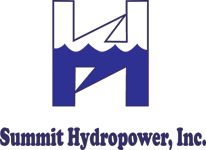

Summit Hydropower, Inc. (SHI) is a Connecticut Corporation in business since 1983. Comprised of President Duncan Broatch plus several employees, SHI develops, builds, refurbishes, maintains, operates, leases and owns hydroelectric facilities. Most of our work involves sites owned by SHI, however, we occasionally provide services for outside customers on a limited basis. SHI's goals are to provide long term benefits to future generations and our environment by developing and improving hydropower projects in an environmentally responsible fashion while maintaining uncompromising safety and high quality workmanship standards. SHI currently owns and operates two hydro facilities located in Eastern Connecticut: Wyre Wynd Hydro and Dayville Pond Hydro. Electricity from both of SHI's sites is currently sold to the New England grid at wholesale market rates. From the grid, other electric companies buy the electricity and deliver it to their customers.
Hydropower harnesses the energy of falling water to generate electricity. In simple terms, the inertial force of water flowing through a pipe rotates a propeller which is connected to a generator to make electricity.
The capital cost of hydropower projects is higher than fossil burning projects but operating costs are low and there is no dependence on a fuel supply that is depleting and becoming more expensive. The Federal Energy Regulatory Commission (FERC) has sole jurisdiction over hydro in the US. All hydro projects in the U.S. must obtain a FERC license or license exemption unless it has been in continuous operation since 1935. Obtaining a license is extremely complicated. Many State and Federal agencies must be consulted, studies must be performed, and a detailed license application must be submitted for approval. Hydro is considered to be one of the most highly regulated industries in our nation. All entities including state, federal and local agencies, organizations, municipalities and citizens have a say in the crafting of the FERC license. The consultation process is exhaustive. During the late 1800’s and early 1900’s hundreds of dams were built along New England’s rivers for the primary purpose of providing power for manufacturing mills. At most mills the water (hydro) turbines powered equipment directly through a series of belts and shafts. After the advent of motors and generators the turbines were fitted with generators to provide electricity to drive motors in the mills. During the 1900’s most of the hydro turbines at these dams were retired as the mills received electricity from the grid or the manufacturing companies went out of business. During what I call the “hydro gold rush days” of the 1980’s many of the economically feasible retired dams were rehabilitated to generate electricity again. At that time hydro development was spurred by attractive power purchase rates, long term power purchase agreements with the utilities and energy tax credits. Depending on the condition of the extant turbines and generators the rehabilitation involved either reconditioning the existing equipment (eg. Dayville Pond) or installing new equipment (eg. Wyre Wynd).
Summit Hydropower - Avon Connecticut
Renewable energy is energy from a non-depleting source. Common renewable technologies include hydro, wind, solar photo voltaic, solar thermal, biomass, tidal, wave and geothermal.
Chart of New England's Energy Mix
SHI's philosophy is that our society consumes electricity and the electricity must be generated from generating plants somehow, somewhere. The best way to reduce negative impacts of generating plants is to conserve our use and thus use less. However, even with the employment of the best conservation practices we will still need generating plants. With current technology there is no single renewable generating technology that can supply all of our electricity needs while providing the lowest environmental impact. We cannot obtain all of our electricity from just hydro, solar, wind, biomass, etc. In Connecticut, about 10% of our electricity is from hydro, 75% of which is from Hydro Quebec. Nationally, hydro provides about 7% of our electricity. The answer is to develop and utilize all renewable sources of electricity that, when prudently analyzed, provide the greatest benefits with the lowest negative impacts. SHI also believes that renewables need and deserve incentives in the form of financial assistance. This is justified due to the additional benefits that renewables provide our society and our environment as compared to non-renewable plants. However we do not believe in providing incentives that result in 'renewables at any cost'. There is a limit. For example it does not make sense to spend 1 million dollars on a renewable project if it only produces 500,000 kWH per year (unless there are some very site-specific overwhelming benefits for a particular project). Although SHI has not utilized any grants or low interest loans we believe that such incentives, whether from the CT Clean Energy Fund, DOE, or US Government, are all monies derived from the pockets of hard working citizens. There is no such thing as 'free money'. Each and every dollar of incentive money was earned by some citizen thus it should be utilized wisely and efficiently. Now is a good time to promote hydro. Ironic as it may seem, one of the worlds greatest projects, the Hoover Dam, was built in the midst of the great depression in the 1930's. President Herbert Hoover did a bold move by promoting this huge project in tough times. The dam project employed 21,000 people, and has an installed capacity of about 2,000 MW. As a comparison, Connecticut's demand is about 5,000 MW.
New England’s energy mix is as follows:
| Company Name | Summit Hydropower, Inc |
| Business Category | Hydro |
| Address | Hartford Pike Danielson Connecticut United States ZIP: 06239 |
| President | NA |
| Year Established | NA |
| Employees | NA |
| Memberships | NA |
| Hours of Operation | NA |
| Phone Number | Locked content | Subscribe to view |
| Fax Number | Locked content | |
| Locked content | ||
| Website | Locked content |